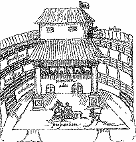Staging Romeo and Juliet
Balconies and tombs: "above" and "within." Romeo and Juliet is a feast of staging. It is as if Shakespeare used every stage trick he could to heighten the drama; there is the dance, and two passionate, intense duels (3.1 and 5.3).
There is much we don't know about the stage Shakespeare wrote for. For example, the most detailed early sketch of the stage shows spectators where we would expect Juliet on the balcony, and nowhere for the tomb she dies in.
A good example of the flexibility of Shakespeare's stage is the scene where Romeo stays on stage, while the scene apparently changes from outside the Capulets' wall to inside (2.1-2.2). Modern editors put a scene change here, but there was no break in the first editions, and clearly none for the first audience. Click for Shakespeare's texts and roses.
